Print your PowerPoint slides or handouts
You can use PowerPoint to print your slides (one slide per page), print slides with presenter notes, or print an outline. You can also print handouts of your presentation — with one, two, three, four, six, or nine slides on a page. Your audience can then use these handouts to follow along as you give your presentation or they can keep them for future reference.
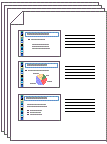
The three-slides-per-page handout includes lines that your audience can use to take notes.
On your PC, you can set the slide size, page orientation, and starting slide number, set printing options, and save your print settings. (For help on printing in PowerPoint 2007, see Print your slides.)
-
Click File > Print.
-
Specify how many copies you want to print.

-
Ensure that the selected printer is the one you want to use.

Click the down arrow, as illustrated, to see more printer options, including the Add Printer command that helps you connect to a different printer available on your network:
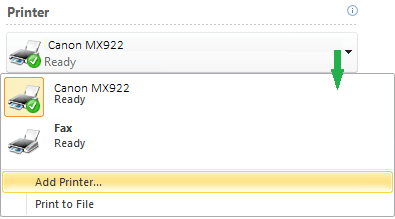
-
If you're through setting print options, select Print. Otherwise, continue to mark other settings (such as which slides to print and the layout for notes or handouts) as described in the following procedures.
If you decide not to print after you've opened the Print dialog box, just switch to another tab on the PowerPoint_generic ribbon, such as Home, to dismiss the Print dialog box.
Specify which pages to print

By default, the first option under Settings in the Print dialog box is set to Print All Slides.
If you don't want to print all slides, in the Slides box, you can type the numbers of the slides to be printed. Type individual slide numbers and/or hyphenated ranges of slides, and separate them with commas (spaces are not necessary):

For example, typing: 1,3,5-7,10 would print slides 1,3, 5, 6, 7, and 10.
You can also click the down arrow and change Print All Slides to another option such as Print Current Slide or Print Selection:
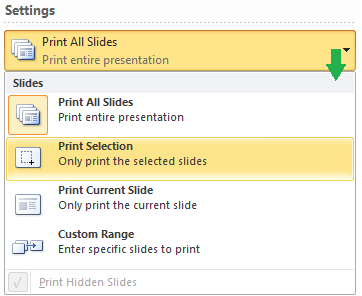
-
To print one or more slides that you select, go back to the Home tab, and in Normal view, select your slides from the thumbnail pane on the left. To select multiple slides, press and hold Ctrl while you click the slides you want to print. When you're done with your selection, click File > Print, and use the Print Selection option.
-
To print the slide that you were working on right before choosing File > Print, use the Print Selection option. (After you choose this option, the preview pane shows you which slide will be printed.)
Print notes and slides
When you print speaker notes, you get one slide per page, with space allotted for speaker notes below the slide. The Preview pane in the Print dialog box shows you what your printed page will look like.
-
In the Print dialog box, under Settings, select the second box (which by default is set to Full Page Slides) to expand the list of options. Then, under Print Layout, select Notes Pages.
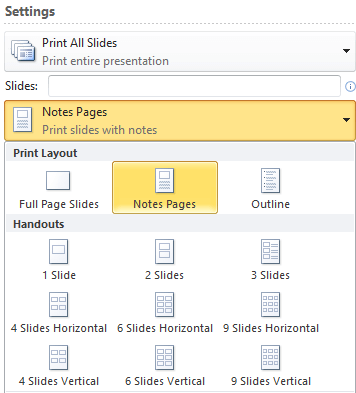
-
If you're through setting print options, select Print. Otherwise, continue to mark other settings as described in the other procedures in this article.
The other options under Print Layout, and all of the options under Handouts, only print slides or slide content, not speaker notes.
Print handouts
You can print handouts that show 1, 2, 3, 4, 6, or 9 slides per page. If you print three slides per page, the slides appear on the left side of the page with printed lines for note-taking on the right side of the page. This "three-up" layout is the only one that includes printed lines for note-taking.
(For information on handout design, such as how to set up slide layouts and orientation or to change your headers, footers, or background, see Create or change a presentation's handout.)
-
In the Print dialog box, under Settings, select the second box (which by default is set to Full Page Slides) to expand the list of options. Then, under Handouts, select the page layout you want.
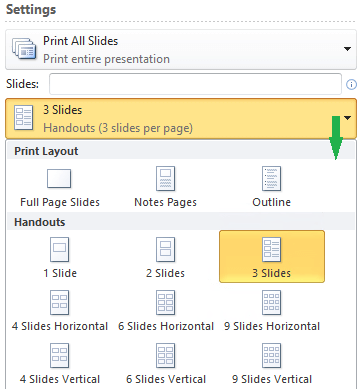
For handout pages containing four, six, or nine slides, there are two options to choose from for each: horizontal ordering (as illustrated in the first picture below) or vertical ordering (the second picture below).
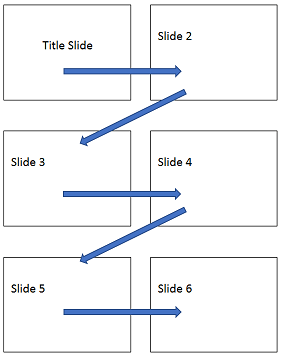
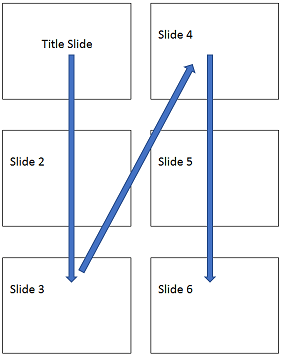
-
If you're through setting print options, select Print. Otherwise, continue to mark other settings as described in the other procedures in this article.
Print full-page slides
With this option you get one slide per page. The orientation (Landscape or Portrait) of the printed pages is automatically matched to the orientation of your slide layout.
-
In the Print dialog box, under Settings, ensure that the second box is set to Full Page Slides. If it isn't, click the down arrow on the control to expand the list of options. Then, under Print Layout, select Full Page Slides.
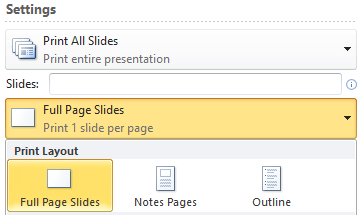
-
If you're through setting print options, select Print. Otherwise, continue to mark other settings as described in the other procedures in this article.
Other layout options:Select Frame Slides to print a thin border around each slide.Select Scale to Fit Paper to ensure that the slide content is printed in the maximum size that will fit on the page size and orientation you've selected. Select the High quality option to increase resolution, blend transparent graphics, and print soft shadows in your printout.If you choose Print Comments and Ink Markup, a separate page is printed for the comments that are in the presentation.
Print an outline
-
In the Print dialog box, under Settings, select the second box (which by default is set to Full Page Slides) to expand the list of options. Then, under Print Layout, select Outline.
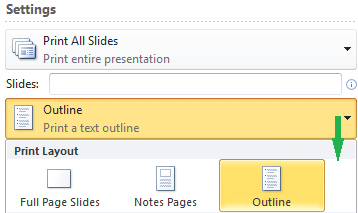
-
If you're through setting print options, select Print. Otherwise, continue to mark other settings as described in the other procedures in this article.
Print quality for graphics, page type, and page orientation

Select the Printer Properties button to:
-
Select an output media on the Paper/Quality tab: Plain Paper, Transparency, Card Stock, Glossy Paper, and so on.
-
Choose a print quality for graphics: This option may vary by printer, but for example, it might mean a choice of either 600 x 600 dots per inch or a more high-resolution 1200 x 1200 dots per inch.
-
Choose a page orientation: PowerPoint usually chooses the right page orientation based on the options you've selected already. But you can choose a page orientation (Portrait or Landscape) in the Printer Properties dialog box.
Choose a color option
Select the Color list, and then select one of the following:
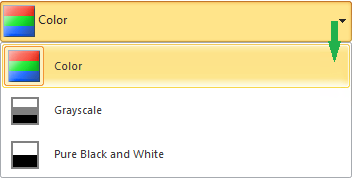
| Option | Description |
| Color | This option prints in color on a color printer. To prevent a color background from printing, you can either print your slides in grayscale (see Grayscale below for more information), or you can remove color backgrounds from your presentation. To remove color backgrounds, on the Design tab, in the Background group, click Background Styles, and then select Style 1. |
| Grayscale | This option prints images and contain variations of gray tones between black and white. Background fills are printed as white, so that the text will be more legible. (Sometimes grayscale appears the same as Pure Black and White.) |
| Pure Black and White | This option prints the handout without gray fills. |
Save default Print settings for a particular presentation
If you want to keep the same print settings for a certain presentation, do the following:
-
On the File tab, select Options > Advanced.
-
Select either Use the most recently used print settings or Use the following print settings. If you choose the latter option, specify the settings that you want, such as what layout to use, and whether to print hidden slides:
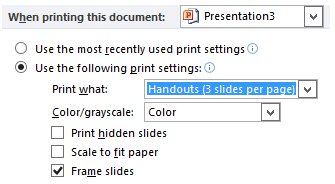
These settings only apply to a single presentation. They don't apply to all presentations that you print thereafter.
On your Mac, you can set the slide size, page orientation, and starting slide number, preview your presentation, and set printing options.
Set the slide size, page orientation, and starting slide number
Follow these steps before you add content. If you change the slide size or orientation after you add content, the content might be re-scaled.
-
On the Design tab, click Slide size > Page Setup.
-
In the Slides sized for list, check the size of paper that you will be using.
Note: To print an overhead transparency, click Overhead.
-
If you select Custom in step 2, type or select the measurements that you want in the Width and Height boxes.
-
To set the page orientation for the slides, on the Page Setup dialog box, under Orientation, click Portrait or Landscape.
Note: All slides in a presentation have the same orientation. Notes, handouts, and outlines can have a different orientation than the slides in a presentation.
-
To number your slides:
-
On the Page Setup dialog box, click Header/Footer.
-
Click Slide number, and in the Starts at box, enter the number that you want to appear on the first slide or handout. Subsequent slides will be numbered sequentially.
-
-
Click Apply, and then click OK.
For more information about configuring slide sizes and saving your selections for future presentations, see Change the aspect ratio (size) of your slides in PowerPoint 2016 for Mac.
Preview a presentation before printing
Presentations can contain graphical elements that may not look the same when you print them. Therefore, it's a good idea to preview the slides before you print.
If you are using PowerPoint 2016 for Mac
-
On the File menu, click Print > Show Details.
-
Select a layout from the Layout list. For example, select Handouts (2 slides per page).
A preview of the layout will appear on the left side of the Print dialog box, You can use the forward and back controls to page through the preview.
If you are using PowerPoint 2011 for Mac
To quickly preview thumbnails of each page:
-
On the File menu, click Print.
-
Select the Show Quick Preview check box.
If you don't see the Show Quick Preview check box, click the arrow
 to expand the Print dialog box.
to expand the Print dialog box. -
Use the arrows under the preview pane to review the slides in your presentation.
To preview pages in full screen:
-
On the File menu, click Print.
-
In the Print dialog box, click Preview.
Set printing options and then print your slides or handouts
Follow these steps to set the printing options (including number of copies, printer, slides to print, number of slides per page, color options, and more), and then print your slides.
-
Click the File tab.
-
If you are using PowerPoint for Mac 2016, click Print > Show Details.
-
In the Printer box, select the printer that you want to use. (If you want to print in color, be sure to select a color printer.)
-
In the Copies box, enter the number of copies that you want to print.
-
Next to Slides, select the slides you want to print:
-
To print all slides, click All.
-
To print a series of slides, click From and then enter the slide numbers in the From and to boxes.
-
To print one or more slides that you select, click Cancel, and on the View tab, in Normal view, select your slides from the left pane. Press and hold the command key
 while you click the slides that you want to print. When you're done with your selection, click File > Print > Selected slides.
while you click the slides that you want to print. When you're done with your selection, click File > Print > Selected slides. -
To print specific slides by number, click Print All Slides > Custom Range, and then enter a list of individual slides by number, a range, or both. Use commas to separate the numbers and no spaces; for example, 1,3,5-12.
-
-
If you are using PowerPoint 2016 for Mac, on the Layout list, select from the following options. If you are using PowerPoint 2011 for Mac, make your selections from the Print What pop-up box.
-
To print one slide on a full page, click Slides.
-
To print one or multiple slides per page in handout format, under Handouts, click the number of slides you want per page.
-
To print your presentation with presenter notes, click Notes.
-
To print an outline of your presentation, click Outline.
-
-
To change the orientation, click the Portrait or Landscape icon.
-
Under Output, select from the following options.
Note: In PowerPoint 2011, you might need to click the arrow
 to expand the Print dialog box.
to expand the Print dialog box. -
Color - This option prints in color on a color printer. To prevent a color background from printing, you can either print your slides in grayscale (see Grayscale below for more information), or you can remove color backgrounds from your presentation. To remove color backgrounds, on the Design tab, click Format Background, and then select Hide Background Graphics.
-
Grayscale - This option prints images that contain variations of gray tones between black and white. Background fills are printed as white, so that the text will be more legible. (Sometimes grayscale appears the same as Pure Black and White.) See the table below for a detailed description of grayscale options.
-
Pure Black and White - This option prints the handout without gray fills.
-
-
To include or change headers and footers, click the Header/ Footer button, and then make your selections. Slides can have footers only. Notes & Handouts can have both headers and footers. Click Apply to All to save your changes.
-
When you are finished with your selections, click Print.
| Object | Shows in grayscale as | Shows in high contrast black-and-white as |
| Text | Black | Black |
| Text shadows | Hidden | Hidden |
| Embossing | Hidden | Hidden |
| Fills | Grayscale | White |
| Frames | Black | Black |
| Pattern fills | Grayscale | White |
| Lines | Black | Black |
| Object shadows | Grayscale | Black |
| Bitmap images | Grayscale | Grayscale |
| Slide backgrounds | White | White |
| Charts | Grayscale | Grayscale |
No comments:
Post a Comment